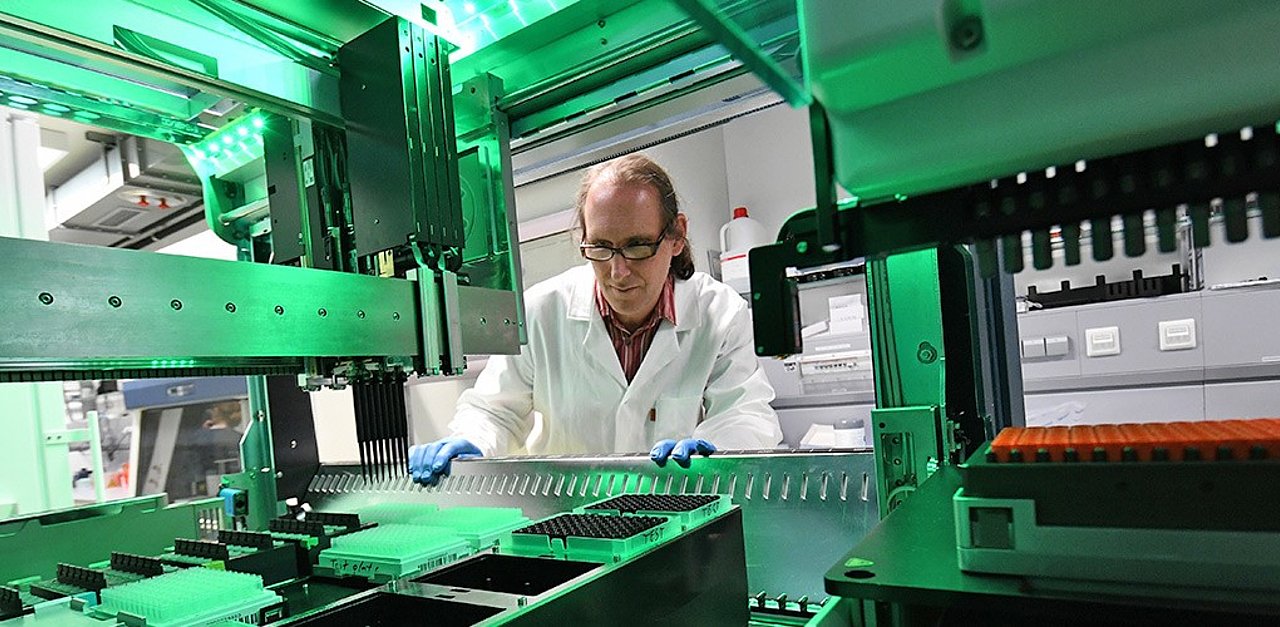The researchers and technicians involved in the Lasers4Life Project (L4L) recently welcomed a new member to the team. Since March, a pipetting robot has taken on the task of processing blood samples for subsequent analysis with an infrared laser. The outcome of such an analysis is a ‘molecular fingerprint’ of the metabolic products present in the sample, which are expected to differ between healthy donors and patients who are ill. Based on these differences, L4L researchers hope to develop a new analytical test for the early diagnosis of cancers. When Dr. Frank Fleischmann enters the new Biolab in the Laboratory for Extreme Photonics, he hopes to see ‘the green light’ – “the green light that signals that the new pipetting robot is working perfectly,” he explains. Fleischmann, an expert in biobank management, supervises the processing of blood samples in the Biolab, before they are subjected to molecular analysis with a dedicated infrared laser. The samples concerned were donated by cancer patients, and by healthy individuals who serve as the control group. Laser spectrometry of these samples provides a molecular fingerprint that reveals the chemical composition of the donor’s blood plasma, which differs in characteristic ways depending on the state of the donor’s health. With the help of these data, L4L researchers hope to develop a method which allows them to identify molecules that are correlated with early stages of disease – in particular, cancers – and can therefore serve as diagnostic biomarkers. “We now have so many samples that automation of processing makes sense,” says Fleischmann, as the instrument quietly gets on with the job. “The apparatus has been modified in accordance with the Biolab’s specifications,” he adds. For example, the instrument is equipped with a decapper, which removes and replaces the caps of the sample tubes automatically. In addition, all sample tubes are individually barcoded, which ensures that each can be traced throughout the procedure. The internal robotic arm that carries out all manipulations has a top speed of 2 m per second and deploys eight pipette tips at once. The machine has enabled the L4L team to process 2500 blood samples since the unit as delivered in April. The robot divides the samples into smaller portions, which subsequently undergo different processing steps. For example, blood serum is required for the laser-based analysis. Serum is the supernatant liquid left behind after the insoluble fraction of clotted blood has been removed by centrifugation. The researchers also use blood plasma – the soluble fraction obtained by centrifugation of whole blood which has been collected in the presence of an anticoagulant that prevents clotting. The Biolab is located immediately adjacent to the Laser Lab, so that the blood samples can be processed by the robot and promptly subjected to laser analysis. “Eventually the robot will be used to process blood samples for basic research on cardiovascular disease,” Fleischmann says. In that case, only donor blood plasma will be processed, since patients who are at risk for heart attacks are normally treated with coagulation inhibitors, and serum therefore cannot be obtained from them. Processing is also more complex, as the instrument will not only dispense samples into smaller aliquots, but also fractionate these into defined sets of components. For detailed laser-based investigations, researchers generally analyze three different fractions of a given sample of serum or plasma. Isolation of these fractions requires a series of steps in which specific sets of proteins are successively removed from the starting sample, and a protein-free fraction is also prepared. The LEX Lab in which the pipetting robot is installed operates in conformity with biosafety level BIO II, because the samples processed here have not been otherwise characterized, and could potentially transmit infectious diseases. The robot provides a further safeguard against such an eventuality, thus further minimizing the risk to which researchers are exposed In the near future the instrument will have a great deal more to do, for the planned L4L study on laser-based early diagnosis of cancer will require the analysis of samples from as many as 37,000 donors. All samples are anonymised before being passed on to the research team, so that only the clinicians responsible for treating the patients are in a position to link specific samples with individual donors. Control samples are still required for the study, and healthy persons are asked to donate blood for this purpose. For further information, see: www.lasers4life.de.
pipetting robot
